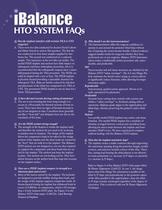 Website:
Arthrex
Website:
Arthrex
Catalog excerpts

HTO SYSTEM FAQs Q. Does the implant interfere with revision TKA or UNI surgeries? A. There were two labs conducted by doctors David Caborn and Akbar Nawab to answer this question. The first lab was conducted on four foam samples supplied by Sawbones Inc. The second was conducted on a cadaveric sample. The experience at the two labs was similar. The medial PEEK implant and anchors have little impact on subsequent total knee arthroplasty procedure, but it is recommended that the orthopaedic surgeon have a micro drill prepared during the TKA procedure. The PEEK can easily be shaped with a saw or burr. The PEEK implant is precisely located providing a repeatable clearance for subsequent TKA. Risks are further reduced by selection and placement of the tibial tray component of a TKA or UNI. The permanent PEEK implant is not an issue for a future TKA procedure. Q. Is there thermal necrosis during cutting of osteotomy? A. The saw is not touching the bone long enough (t.n. occurs at >10 seconds) for thermal necrosis of bone to occur. There have been no signs of thermal necrosis in any of our surgeries to date. Cancellous bone generally acts like a “heat sink” and dissipates heat rise due to the vascularity of the bone. Q. Are the PEEK anchors strong enough? A. The strength of the fixation is within the implant itself, and therefore the anchors do not need to be as strong as stainless steel or titanium. The design of the implant allows the compressive loads to be taken by the wedge portion of the implant and the shear loads are resisted by the “keys” that are built in to the implant. The iBalance HTO anchors are not designed to, nor are they required to, support the compressive and shear loads that are carried by the implant. The anchors just keep the implant in place. The anchors are not locking screws. They have detent features on the anchor head that snap into recesses on the implant surface. Q. How can a PEEK implant compare in strength to a titanium plate and screws? A. Most of the load is carried by the implant. The keyholes are designed to provide stability during shear loads, and the wedge of the implant supports compressive loads. In biomechanical testing the implant has withstood loads in excess of 3,500 lbs. in compression, which is 5X stronger than a 4-hole titanium HTO plate. See Figure 3 in the iBalance HTO white paper (LA0124): Load Bearing Features of Implant. Q. Why should I use this instrumentation? A. The instrumentation offers the surgeon confidence to operate in and around the posterior tibial fossa without fear of injuring the neurovascular bundle. Clinical evidence suggests similar results for surgeons whether they have performed one or ten surgeries. iBalance HTO instrumentation makes a traditionally artistic procedure safe, reproducible, and predictable. Safe Neurovascular and soft tissue structures are shielded by the iBalance HTO “safety envelope”. The 4.5 mm Hinge Pin hole maintains the lateral cortex acting as a stress reliever to significantly reduce fractures, while allowing for larger correction angles. Reproducible Instrumented, guided system approach. Shown to be easily reproduced by physicians. Predictable Accurate bone cutting done entirely with a power saw within a “safety envelope” vs. freehand cutting with an osteotome. Biplanar guide aligns to the sagittal plane and tibial slope, thereby preserving the patient’s native tibial slope. Patient Low profile medial PEEK implant may reduce soft tissue irritation. The medial PEEK implant has a modulus of elasticity averaged between cortical and cancellous bone, allowing for micro strain between the implant and bone interface (Wolf’s Law). We have experienced complete uniform healing with the iBalance HTO implant. Q. How does the implant maintain slope? A. The implant creates a stable construct through supporting the osteotomy opening along the posterior margin, medial cortices, and anterior/medial cortices of the tibia. Therefore, during load bearing the tibial plateau is not allowed to rotate posteriorly (i.e. decrease A/P slope) or anteriorly (i.e. increase A/P slope). Refer to Figure 3 of the iBalance HTO white paper titled Bi-Planar Alignment (LA0122). In case 1, the image shows that if the Hinge Pin orientation is parallel to the tibial A/P slope and perpendicular to the posterior aspect of the tibia (parallel to the sagittal plane), then the tibial A/P slope remains unchanged regardless of the degree of correction. This is achieved with our Bi-Planar Alignment Technique.
Open the catalog to page 1
Q. Can you change slope with iBalance HTO system? A. The iBalance HTO system predictably preserves tibial slope, a requirement in roughly 90% of typical HTO cases. No, slope change is not a feature of this release of the system. Q. Radiolucency? A. The implant has a radiolucency comparable to that of human tissue. Q. A. Is the implant a weak area due to the bone not growing into the implant? Medial PEEK implant has superior strength and can support in excess of 18kN (+4,000 lbf) in compression. It has also been shown in spinal studies that bone will solidly grow up to and encapsulate the...
Open the catalog to page 2All Arthrex catalogs and technical brochures
-
Imaging and Resection Catalog
108 Pages
Archived catalogs
-
Arthroscopic Hand Instruments
28 Pages
-
Foot & Ankle
138 Pages
-
Ankle Arthroscopy
11 Pages
-
Shoulder Repair Technology
114 Pages
-
Foot and Ankle
12 Pages
-
Hand & Wrist
64 Pages
-
Imaging & Resection
80 Pages
-
Hip Labral Scorpion
1 Pages
-
For Fracture Treatmen
8 Pages
-
Clavicle Plate and Screw System
12 Pages
-
A rthrex Graft Tubes
4 Pages
-
HTO Medial PEEK Implant
6 Pages
-
ACL TightRope® RT - LS0178
2 Pages







































